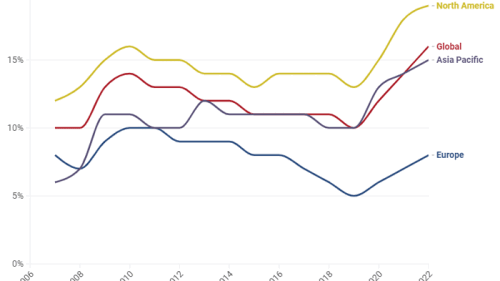Four university teams—including two from Harvard University, one from the University of Maryland, and a joint team of students from the University of Wisconsin at Milwaukee and the University of Wisconsin at Madison—have been selected as the finalists for the 13th annual Urban Land Institute (ULI) Hines Competition, an ideas competition that challenges graduate students to create proposals for the development or redevelopment of a designated site in a U.S. metropolitan area. The competition is open to graduate students who are pursuing real estate–related studies at universities in North America.
Related: New Orleans Site Selected as Study Area for 2015 Hines Competition | ULI Hines Competition: A Turning Point for Rameez Munawar
The 2015 competition challenged multidisciplinary student teams with the task of devising a comprehensive design and development program for parts of the Tulane/Gravier and Iberville neighborhoods in downtown New Orleans. This year’s competition is designed to simulate an actual urban design and development scenario, with certain details changed for the purposes of the competition. In April, a $50,000 prize will be awarded to the team with the winning proposal, with $5,000 of the total going to the school. Each of the remaining three finalist teams will receive $10,000. This year, 120 teams comprising 600 students from 60 universities participated in the first round of the competition.
The Tulane/Gravier and Iberville neighborhoods, which make up a historically rich area in the city’s core, contain a mix of residential, industrial, and commercial zoning that includes manufacturing plants and other small industrial complexes—many defunct, others still operational. The competition scenario is based on a hypothetical situation in which community stakeholders, including residents, landowners, local businesses, and others in the area bound by the upcoming Lafitte Greenway, the eastern edge of the new medical district, and crossed by the elevated I-10 highway, have come together to create the North Claiborne Neighborhood Improvement Association (NCNIA)—a fictional entity created for the purpose of the competition. The NCNIA is seeking a master-plan proposal that not only transforms the area into a thriving urban neighborhood, but also highlights its locational advantages, including its proximity to the French Quarter, adjacency to the medical district, and interaction with the Lafitte Greenway.
While based on a hypothetical situation, the 2015 Hines Competition reflects many real-life concerns of New Orleans. The competition addresses the city’s continued effort to develop sustainable neighborhoods that represent the city’s uniqueness with the promise of economic innovation and inclusion, as well as access to cultural, employment, transportation, and housing resources. As part of these efforts, the city recently completed the Livable Claiborne Communities (LCC) study.
The finalist teams and development schemes are as follows:
- Harvard University: Inspired by the architectural and cultural heritage of the project site and its adjacency to major city destinations and amenities, “Claiborne Grove” recalls the rich landscape that once characterized North Claiborne Avenue and prioritizes redevelopment of the street most critical to the growth and transformation of the neighborhood. The proposal’s central design element is “the Grove,” a linear multipurpose park and urban landscape sited below elevated Interstate 10.
- Harvard University: The project “Tremé 2.0” lies at the southern tip of the old Tremé district, one of New Orleans’s first urbanized neighborhoods outside of the Vieux Carré rampart. The proposed 23-acre development project anticipates Tremé’s continuing its great tradition of innovatively transforming the Crescent City, as it did 200 years ago.
- University of Maryland: “The Crossing” development sows the seeds of resilience across the Bienville, Iberville, and Lafitte neighborhoods. By connecting tourist and native, greenway and park, neighborhood and city, the Crossing functions as a marketplace not only of goods, but also of ideas and relationships. This commingling of people and place fosters diversity, neighborhood cohesion, and economic opportunity.
- University of Wisconsin at Milwaukee and the University of Wisconsin at Madison: “Quartier Vert” creates a vision of a community that operates as an intersection between communities, corridors of activity, and a variety of users. Each of these strategies comprises a neighborhood fabric that suggests the interaction between the site and its neighbors. Capitalizing on the existing locational and socioeconomic advantages of the area, Quartier Vert seeks to revive and enhance the surrounding community.
“All of the finalists make bold proposals for reenvisioning an area that is rich in potential,” said J. Michael Pitchford, jury chairman and president and chief executive officer at CPDC in Silver Spring, Maryland. “This year’s submissions provide new approaches for how a combination of uses all work together to create an attractive destination that is financially realistic. These entries are all reflective of an up-and-coming generation that will provide fresh ideas worth exploring in the creation of sustainable urban landscapes.”
In addition to the four finalists, the jury selected eight team proposals for honorable mention. The Hines Competition is part of an ongoing ULI effort to raise interest among young people in creating better communities, improving development patterns, and increasing awareness of the need for interdisciplinary solutions to development and design challenges. The competition is strategically structured to encourage cooperation and teamwork—necessary talents in the planning, design, and development of sustainable communities—among future land use professionals and allied professions, such as architecture, landscape architecture, urban planning, historic preservation, engineering, real estate development, finance, psychology, and law. The competition is designed as an exercise; there is no intention or expectation that the students’ plans will be implemented as part of any revitalization of the site.
In the final phase of the competition, the student finalist teams will have the opportunity to expand their original schemes and respond in more detail. Next month, a member of each team will be brought to New Orleans to tour the site and revise his or her team’s presentation. On April 9, finalist team members will present their schemes to the competition jury members during a public forum in New Orleans. The event will culminate with the announcement of the winning team.
For more information on the ULI Hines Competition, visit http://uli.org/hines.




